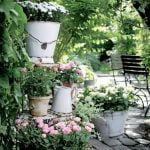Are you looking for gardening ideas for small gardens? Limited space doesn’t have to mean limited possibilities. In fact, small gardens offer a unique charm and an exciting challenge for gardeners. With the right strategies and techniques, you can create a stunning and productive garden in even the most compact of spaces.
Small gardens may present certain limitations, but they also provide endless opportunities for creativity and innovation. From maximizing vertical space to designing for impact, there are numerous ways to make the most out of your tiny garden oasis. In this article, we will explore a variety of gardening ideas and tips specifically tailored for small gardens, allowing you to turn your limited space into a flourishing green haven.
Understanding the unique charm and challenge of small gardens is the first step towards creating a successful and enjoyable garden experience. Whether you’re working with a tiny urban balcony or a modest backyard, there are plenty of innovative approaches that can help you unlock the full potential of your small garden. Let’s dive into the world of gardening ideas for small gardens and discover how to make every inch count.
Maximizing Vertical Space
Small gardens may lack horizontal space, but they offer plenty of vertical potential. By maximizing vertical space, gardeners can make the most out of their limited area and create a lush and thriving garden. Here are some innovative ideas for utilizing trellises, hanging baskets, and wall-mounted planters to transform your small outdoor space.
Trellises
Trellises are a great way to add vertical interest to a small garden. They provide support for climbing plants such as vines, flowers, and vegetables, while also adding visual appeal. Whether made of wood, metal, or other materials, trellises can be leaned against walls or freestanding within the garden to maximize growing space.
Hanging Baskets
Hanging baskets are perfect for small gardens as they allow plants to be suspended in the air, freeing up ground space. These versatile containers can hold a variety of plants such as trailing flowers, herbs, or even strawberries. Hang them from pergolas, fences, or hooks on exterior walls for a stunning display.
Wall-Mounted Planters
For gardens with limited ground space, wall-mounted planters can be a game-changer. These containers can be easily attached to exterior walls or fences and planted with edibles or ornamentals. Additionally, by varying the sizes and shapes of the planters and choosing an assortment of plants with different colors and textures, you can create a living wall that adds vibrancy to your small garden.
By incorporating these vertical gardening ideas for small gardens into your outdoor space, you can turn any limited area into a beautiful and productive oasis that fulfills your gardening aspirations. Whether you have a balcony, patio or tiny yard, there are numerous ways to take advantage of vertical space in order to cultivate a flourishing garden.
Container Gardening
When it comes to gardening ideas for small gardens, container gardening is a popular and practical solution. Choosing the right pots and plants for small spaces is essential in maximizing the potential of your limited area. When selecting containers, opt for lightweight materials like plastic or fiberglass to make moving them around easier. Hanging baskets, window boxes, and wall-mounted planters are also great options for small gardens as they utilize vertical space while adding visual interest.
In addition to choosing the right pots, selecting the appropriate plants is crucial for successful container gardening in small spaces. Consider the growing conditions of your garden – whether it’s sun or shade – and choose plants that thrive in those conditions.
Herbs like basil, mint, and rosemary are perfect for small-scale edible gardening in containers, as are compact vegetables like cherry tomatoes and peppers. Flowers such as petunias, pansies, and marigolds are excellent choices for adding color and vibrancy to your small garden.
Remember to consider the size of your plants at maturity when planning your container garden. Avoid overcrowding by selecting plants that won’t outgrow their containers, ensuring a visually appealing and well-maintained garden throughout the seasons. By carefully choosing both the pots and plants for your small space, you can create a beautiful and thriving garden regardless of its size.
Intensive Planting
When working with limited space in small gardens, it’s essential to maximize every inch of available soil. Intensive planting is a gardening technique that focuses on planting crops and flowers close together to make the most efficient use of space. Here are some tips for successful intensive planting in small gardens:
- Choose compact varieties: When selecting plants for your small garden, opt for compact or dwarf varieties that take up less space but still offer a high yield or vibrant blooms. Examples include cherry tomatoes, bush beans, and mini sunflowers.
- Use intercropping and companion planting: Intercropping involves growing different types of plants in close proximity to one another, while companion planting involves pairing plants that benefit each other. For example, planting lettuce between rows of carrots or radishes can maximize space and promote healthier growth.
- Utilize succession planting: Instead of waiting for one crop to finish before planting another, practice succession planting by sowing new seeds as soon as the previous crop is harvested. This ensures continuous productivity throughout the growing season.
Intensive planting not only allows you to grow more in a small garden but also helps suppress weeds by shading the soil and maximizing water use efficiency. With careful planning and attention to plant spacing and variety selection, you can create a lush and productive garden in even the smallest outdoor spaces.
By implementing these intensive planting techniques, you can transform your small garden into a bountiful oasis teeming with an abundance of vegetables, herbs, flowers, and fruits. Embracing this approach will not only make your limited gardening space feel more expansive but will also provide you with a rewarding and sustainable way to connect with nature right at home.
Small-Scale Edible Gardening
Small gardens offer a unique opportunity to grow your own herbs, vegetables, and fruits even in limited space. With the right gardening ideas for small gardens, you can create a bountiful edible garden that not only provides fresh produce but also adds visual appeal to your outdoor space. Here are some tips for successful small-scale edible gardening:
- Vertical Gardens: Utilize vertical space by growing climbing plants such as cucumbers, tomatoes, and peas on trellises or in wall-mounted planters. This not only saves ground space but also adds a lush, green backdrop to your garden.
- Container Gardening: Choose compact varieties of herbs like basil, thyme, and mint to grow in pots on your patio or balcony. You can also grow small fruit trees like dwarf citrus trees or berry bushes in containers.
- Intensive Planting: Make the most of every inch of available soil by using companion planting techniques. Pairing compatible plants together can maximize yields and save space.
In addition to traditional vegetable beds and herb patches, consider incorporating edible plants into your existing landscaping. For example, replace ornamental shrubs with blueberry bushes or line the perimeter of your garden with a row of strawberries.
By embracing these small-scale edible gardening ideas for small gardens, you can enjoy the satisfaction of growing your own food while adding beauty and interest to your outdoor space. Whether you have a small backyard, balcony, or just a few square feet of sunny spot, there are plenty of options for creating a productive and visually appealing edible garden.
Designing for Impact
One of the most effective ways to design for impact in a small garden is by choosing a color scheme that harmonizes with the space. Bold, bright colors can add excitement and energy, while a more muted palette can create a sense of calm and serenity. Consider using flowers with different bloom times to ensure that your garden is constantly filled with color throughout the growing season.
In addition to color, texture also plays a crucial role in creating visual interest. Mixing different textures such as smooth leaves against rough bark or delicate flowers against large foliage can add depth and complexity to your garden. Incorporating plants with varying heights can also contribute to the overall visual impact by adding layers and dimension to your small space.
Focal points serve as the centerpiece of your garden design, drawing the eye and providing a sense of direction. In a small garden, incorporating one or two carefully chosen focal points can make an enormous difference in the overall aesthetic. This could be an architectural element, a unique sculpture, or even an exceptionally striking plant. By carefully considering how these elements work together, you can craft a visually stunning small garden that feels anything but limited.
| Design Element | Impact |
|---|---|
| Color Scheme | Creates visual interest and sets the tone for the space |
| Texture Variation | Adds depth and complexity to the overall aesthetic |
| Focal Points | Serve as centerpieces that draw the eye and provide direction |
Low-Maintenance Solutions
Low-maintenance gardening is essential for small gardens, as it allows you to enjoy a beautiful outdoor space without spending hours on upkeep. With the right plant selection and design choices, you can create a low-care garden that still looks stunning all year round.
Choosing Low-Care Plants
When selecting plants for your small garden, opt for varieties that require minimal maintenance. Native plants are often well-adapted to the local climate and soil conditions, making them easier to care for. Succulents and drought-tolerant plants are also great choices for low-maintenance gardening, as they require less water and attention. Additionally, consider incorporating perennial plants that come back year after year without needing replanting.
Easy-to-Maintain Designs
In addition to choosing the right plants, the design of your small garden can also impact its maintenance needs. Consider using mulch to suppress weeds and retain moisture in the soil, reducing the need for frequent watering and weeding. Incorporating hardscaping elements such as pathways and containers can also minimize maintenance by reducing the amount of open soil that needs tending.
Sustainable Practices
Implementing sustainable gardening practices can further reduce the maintenance requirements of your small garden. For example, using organic fertilizers and natural pest control methods can help promote healthy plant growth without requiring frequent applications or treatments. Additionally, practicing proper pruning techniques and efficient watering methods can contribute to a lower-maintenance garden overall.
By incorporating these low-maintenance solutions into your small garden design, you can create a beautiful outdoor space that brings joy without demanding excessive time and effort. With careful plant selection and thoughtful design, even a small garden can become a thriving oasis with minimal maintenance requirements.
Seasonal Tips
Having a small garden doesn’t mean you can’t enjoy the pleasures of gardening all year round. Adapting your small garden to thrive in different weather conditions is essential for its success. During the warmer months, it’s important to provide adequate water and protection from the sun, while in colder months, you’ll need to implement strategies to protect your plants from frost and freezing temperatures.
During the spring and summer, be mindful of watering as small gardens can dry out quickly. Consider installing a drip irrigation system or using self-watering containers to ensure your plants receive the moisture they need. Additionally, providing some form of shade during the hottest parts of the day can prevent delicate plants from wilting or burning in the intense sun.
As fall approaches and temperatures begin to drop, it’s crucial to prepare your small garden for the colder weather. Consider using row covers or cloches to protect sensitive plants from frost, and bring potted plants indoors if necessary. You may also want to add a layer of mulch around your plants to help insulate the soil and retain heat during chilly nights.
When winter arrives, it’s time to focus on protecting your small garden from freezing temperatures. Consider utilizing cold frames or temporary greenhouses to keep your plants warm and sheltered from harsh winter conditions. You can also select cold-tolerant plant varieties that are suited for winter gardening in smaller spaces.
By adapting your gardening techniques according to seasonal changes, you can ensure that your small garden thrives throughout the year. Whether it’s providing shelter from the summer heat or safeguarding against winter frosts, there are numerous ways to help your small garden flourish no matter what Mother Nature has in store.Gardening ideas for small gardens.
Conclusion
In conclusion, small gardens may present a unique set of challenges, but they also offer a multitude of opportunities for creativity and innovation. By implementing the various gardening ideas for small gardens outlined in this article, you can transform your compact outdoor space into a lush and thriving oasis. Whether it’s through maximizing vertical space, container gardening, intensive planting, or incorporating small-scale edible gardening, there are numerous ways to make the most of every inch available.
Furthermore, designing for impact with color, texture, and focal points can create visual interest and make your small garden feel like a luxurious retreat. And by selecting low-maintenance plants and designs that are easy to care for, you can ensure that your garden continues to flourish with minimal effort. Additionally, adapting your small garden to thrive in different weather conditions allows you to enjoy your outdoor space year-round.
Ultimately, gardening in a limited space is not only possible but also immensely rewarding. The joy of tending to your plants and watching them thrive is unparalleled. Embracing the potential of small gardens allows you to connect with nature and experience the fulfillment that comes from nurturing living things. So whether you have a tiny balcony or a petite backyard, take advantage of these gardening ideas for small gardens and transform your space into a flourishing green sanctuary.
Frequently Asked Questions
What Is Best for a Small Garden?
The best approach for a small garden is to maximize the use of space. Consider using vertical gardening techniques, such as trellises or hanging planters, to make the most of limited ground space. Additionally, selecting compact varieties of plants and strategically placing them can help create a lush and inviting small garden.
How Do You Arrange a Small Garden?
When arranging a small garden, it’s essential to carefully plan the layout to make the most of the available space. Consider creating focal points with colorful plantings or unique features like a small fountain or sculpture. Grouping plants with similar care requirements together can also make maintenance easier and ensure that each plant thrives in its environment.
How Do You Make a Small Cute Garden?
To make a small garden cute and inviting, pay attention to details like adding charming decorative elements, such as colorful pots or whimsical garden ornaments. Incorporating cozy seating areas and pathways can also enhance the charm of the space.
Selecting a variety of plants with different textures and colors can add visual interest and create an enchanting atmosphere within a small garden setting.

Welcome to my gardening blog! I am passionate about plants and enjoy sharing my knowledge and experiences with others. In this blog, I will write about everything related to gardening, from tips on how to get started to updates on my own garden projects.





